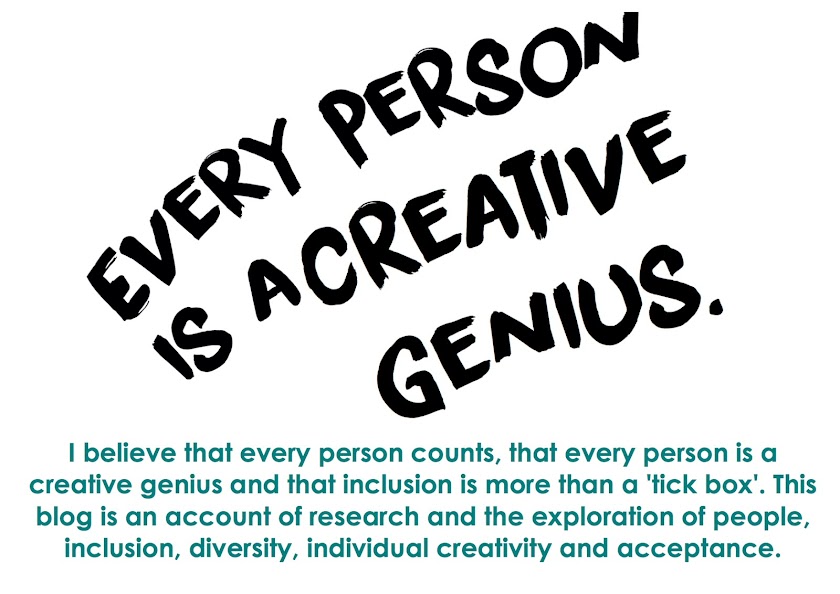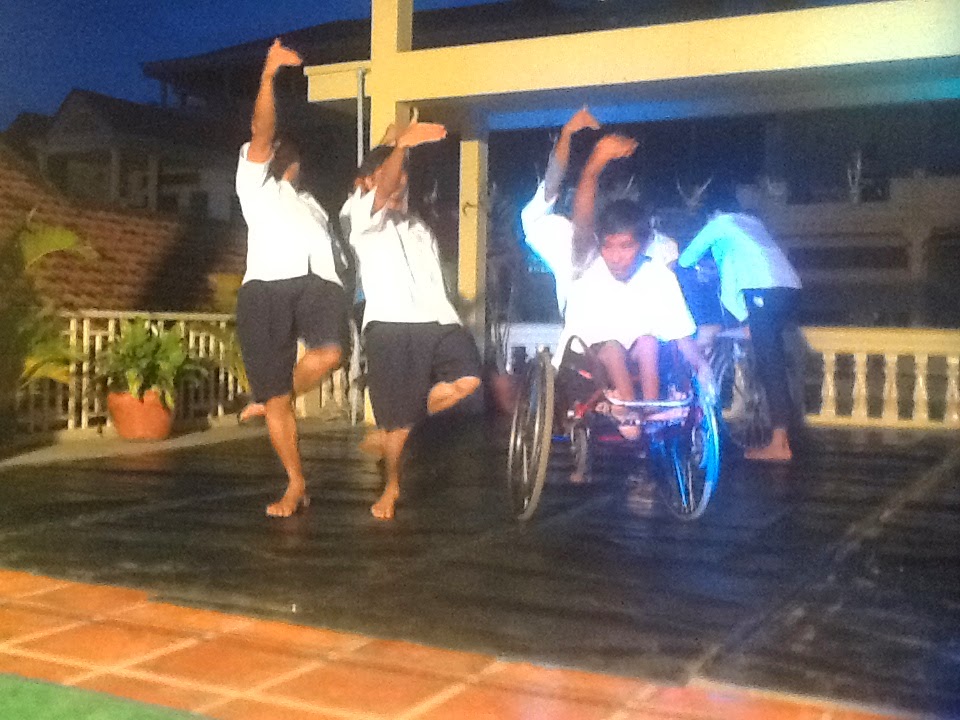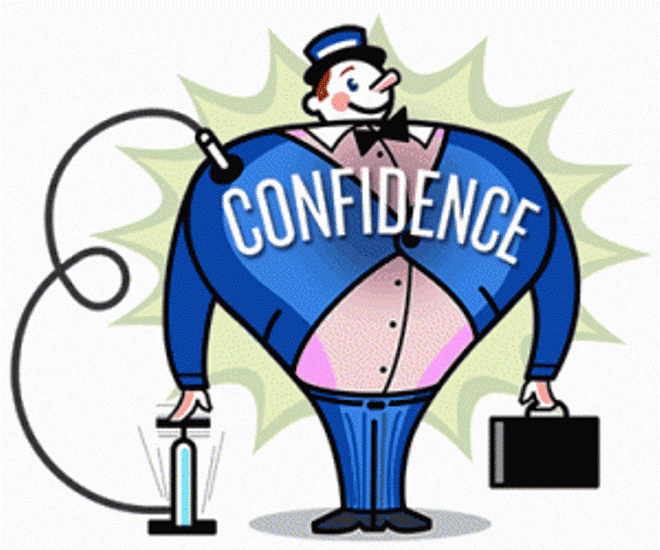As part of this research project I will interview Participants, Facilitators
and Programme Managers at Epic Arts in Cambodia and then in the UK. The first
interview I did was with someone who participated in an Epic Arts activity.
They participated in the inclusive arts practice at Epic Arts as an audience
member at a performance by Epic Encounters.
Epic Encounters are a group of talented dance and theatre
performers from Epic Arts in Cambodia. Consisting of hearing impaired,
physically disabled and non-disabled performers, they are the first and only
fully inclusive dance company in South East Asia. The Epic
Encounters team tour nationally and internationally creating
and performing educational theatre and dance performances.
At this event Epic Encounters performed a piece called ‘Touch’. ‘Touch’ was
commission by the organisation LOVE 146 and was devised from the ‘Good Touch
Bad Touch’ programme in Cambodia.
The aim of the performance is to raise awareness of child
sexual abuse in Cambodia. ‘Touch’ aims to help vulnerable people, especially
school-aged children, to understand what to do if sexual abuse occurs. The
performance uses the ‘Good Touch, Bad Touch’ flip-chart project as the basis for the
story and is performed in schools and communities in Cambodia alongside
training delivered by Love 146 and an accompanying movement workshop delivered
by Epic Encounters that highlights the main issues in the piece.
I interviewed Glenn Miles after the performance.
Glenn is the Asia
Capacity Building Facilitator at Love 146 and he commissioned Epic Encounters
to create the educational theatre piece ‘’Touch’ this year.
.jpg) |
| 'Touch' Poster |
Interview with Glenn Miles PhD @ Love 146 about
‘Touch’
by Epic Encounters
Interview Questions and Answers
 |
| Glenn Miles PhD |
Epic Arts
is an inclusive arts organisation. After seeing Epic Encounters perform, how
would you describe inclusive arts?
Glenn: When you first see the Epic
(Encounters) performers the first thing you see is their amazing ability, creativity
and fun and also that they really draw you in and pull out emotions from you. The
second thing that you realise is that there are people there with certain
disabilities, but the issue that they are addressing is not primarily about
disability, the issue they are
tackling on stage is a relevant issue for everyone and they (the performers) have a voice and
opinion about it - it's a strong message and you focus on that not on the
performers disabilities. I think this performance could be done for any audience;
it's not specifically for people with disabilities or about disability, which
makes it different from a lot of things I have seen created by people with
disabilities.
 |
| Epic Encounters performing 'Touch'. June 2014 |
I
love the huge amount of energy that the group are able to draw on and use and
it feels as though there is a sense of community in the group, which really
adds to the performance. Everyone knows each other and there is a bit of joking
around even when the group are just getting things prepared for the performance
and that's a really positive thing to see. I think building communities is a
hard thing, but I think building communities with so many different abilities
must be harder, but you really feel that sense of community there between the
performers (from Epic Arts).
Can you
explain your experience of the performance? What did it make you feel and think
about?.....Can you give me an
example?
Glenn: I work within the area of preventing
abuse of children in Cambodia and I think this performance brings a fresh look
at this issue. Sometimes it's not enough to engage people with statistics,
peoples emotions need to be stirred a bit, but that's also the risk of this
performance too, as some of the emotions that can be drawn out of people
(during the performance) can be painful. I think that it is good for people
to be taken to a level where they have to engage with the issues and face it
rather than just seeing statistics on a page.
"I felt like I was very much heard in the creative process, not just seen as 'the donor' funding the piece. I felt very much included in the process."
I
invested a lot in this project so I really wanted to make it work and I was
really thrilled when I saw it all come together - it was even better than I
expected. I can see that the choreography and the music and the technical side
of the performance are of high quality and the way all of that comes together
to make a 20 minute performance produces something amazing and profound and as an
audience member you feel very much a part of it.
I
felt like I was very much heard in the creative process, not just seen as 'the
donor' funding the piece. I felt very much included in the process. Epic is
inclusive of disabled and non-disabled people but there seems to be an inclusive
attitude in everything and I experienced this even in creating this work, I was
included in the process. My ideas were heard and I was involved. Even when
creating the workshop (to accompany the performance), again there was dialogue,
I was consulted on what needed to be included in the workshop and now I have
seen the plans, I can see I was listened to and my ideas included.
I
like how the performers are involved in teaching the workshop after the
performance and that the audience have the people who have just performed
interacting with them. This also happened at the beginning (of the performance) with the sign
language lesson that some of performers gave, the audience are engaged and the performers are making the
audience feel at ease with them. They (the Epic Encounters performers) got one
boy on to stage and were communicating with him, making eye contact and
encouraging him and seeing what he had learnt (from the sign lesson).
I think in this culture, where people with disabilities are seen as nothing, to put them in the role of a teacher is actually incredibly significant and for the Cambodian children to see that and for them to learn that these people do things like them, it's very much part of the learning process for them. It was clear that the deaf performer leading the discussion in the workshop and the translator in the wheelchair were in charge - they were teaching. I think this role as a leader that the performers put themselves in is successful because of the confidence that they have, they come over as strong and in charge, not in a brash or over bearing way, but in a positive welcoming way. Why wouldn't you respond to that because it's a very warm, caring and open attitude?
I think in this culture, where people with disabilities are seen as nothing, to put them in the role of a teacher is actually incredibly significant and for the Cambodian children to see that and for them to learn that these people do things like them, it's very much part of the learning process for them. It was clear that the deaf performer leading the discussion in the workshop and the translator in the wheelchair were in charge - they were teaching. I think this role as a leader that the performers put themselves in is successful because of the confidence that they have, they come over as strong and in charge, not in a brash or over bearing way, but in a positive welcoming way. Why wouldn't you respond to that because it's a very warm, caring and open attitude?
"I think in this culture, where people with disabilities are seen as nothing, to put them in the role of a teacher is actually incredibly significant and for the Cambodian children to see that and for them to learn that these people do things like them."
What did you see in the performance that helped
you to understand the idea of being inclusive?
Glenn: I think part of the experience (of
the Epic Encounters performance) is that the disabilities fade and the
creativity comes to the forefront, it's like the ‘disability’ gets pushed back
and that's not the issue. You expect the performers disabilities to be the dominant
issue in the performance at the beginning, but then it's just not at all.
Because the subject matter is not about disability, the focus is on the theme and
the theme can be accessed and related to by all, so the disability issue you
think will be the focus of the piece isn’t, they are just performing about
an important social issue. You think about the subject that they are discussing
on stage not their disabilities.
It's
the same for MOTO MOTO (a road safety piece by Epic Encounters), both of the
performances are issue-based pieces and are phenomenal in that way that they communicate a message. As you watch the team perform, the acceptance of disability
is subconscious and you are focusing on what is being performed and the theme,
not on their ability as performers.
What do you think are the benefits for the
audience of this performance? What do you think they learnt or understood about
the subject matter and about inclusivity?
At
the beginning of the performance when they (the Epic Encounters performers) do
the sign language introduction lesson, the audience are learning that people
who are deaf need to have sign language to be able to communicate, but this is
in no way pushed on you, it's just 'this is what we do'. For most children it's
fun for them to see and be involved in, it's a new experience and many are not
even aware that deafness exists or how people live with this disability in Cambodia.
For
us at Love 146, we wanted to see the issue of child sexual abuse portrayed
through the performance and that is what I love about this performance in that
it doesn't hide away from reality; abuse is painful and difficult, it's not
just something that happens and then it goes away again, it's something that
has lasting affect. The piece very clearly shows that abuse has that
affect on people long after it happens, but that there is hope, there is a
future afterwards with the right help. This is so important for the piece, as
not having that ending would make it very negative. Also I think it normalises
the idea that both boys and girls can be sexually abused, it isn't explicit, but
it's clear enough through the body language and the use of touch what is
happening in the performance.
"I think part of the experience is that the disabilities fade and the creativity comes to the forefront, it's like the ‘disability’ gets pushed back and that's not the issue."
Did you see anything in the performance that you
felt excluded you or that would exclude others?
The
children in the audience did get bored at the beginning when listening to the
introduction about Epic Arts, it was too long for them and that could exclude
them by making them disinterested at the start. It's important to know who the
audience is and what they need. Excluding is not just about disability and
ability issues but also about including all people by knowing what they
need and when. That was the only thing that I think could cause the children in the audience to feel
disengaged and not included in the performance.
What would you say are the attitudes people need
to have to be inclusive in day-to-day life?
People
need to be good listeners; this is a very important skill. Sometimes people want
to give advice rather that listen. It's typical of Cambodian culture to not
listen to children or to people who are seen to be inferior and that people
should always be advising, not necessarily just there to listen. Sometimes
giving advice can feel like you are being helpful, but unless you really listen
to what peoples needs are, you are not valuing them. People are the experts of
themselves; we are the experts of our own reality and know ourselves the best,
so sometimes listening is better than advising as we can all learn about and
from each other - we are not experts in each other realities.
Body
language is very important, I can see the deaf community are very aware of
their own and of others body language. So much of what we communicate is
through body language and I've noticed when I am around the deaf people from
Epic Arts, I become very aware of my body language, as I feel they can read me.
Your body language can be welcoming or unwelcoming, but you can be the feeling
the opposite. It's important when communicating to be open in our body language
and aware of it in order not to exclude people with your body language.
"People are the experts of themselves; we are the experts of our own reality and know ourselves the best……. we are not experts in each other realities."
Inclusive
attitudes of people need to be extend to all; accepting everyone regardless of
their status or experiences, abilities or background. It is important to see
all people as people. I see through my work that the ‘healing’ of people with personal difficulties, emotional problems or physical sickness is often about including
them in society as much as it's about providing solutions, emotional and/or
physical healing. Inclusion and acceptance promotes emotional and physical
healing in many cases. Compassion is important, but reaching out to the most
vulnerable, the most unaccepted in society and accepting and including them is
key to grow and survival.
What has this told me about the inclusive arts
practice within this activity at Epic Arts? What are the key themes?
 |
| Care Glenn points out the caring and open attitude of the performers towards the child who gets up on stage to demonstrate the sign languages he has learnt. He says that the child responds easily to the caring, warm attitude shown. |
 |
| 'Listening' Glenn talks about listening in two places in this interview. He says that he felt 'listened to' and therefore included in the creative process with the organisation and also he identified it as a skill for being inclusive. Being a good listener helps someone to be included as they feel valued and by listening we can learn how to include someone from their own ideas and viewpoint |
Areas for improvement at Epic Arts regarding
anything that was thought to exclude people?
Glenn noted that the only area that excluded some of the audience was the introduction to Epic Arts at the beginning of the performance. This introduction is interesting and relevant to some people who come to watch Epic Encounters performances, but the children did not need to know so much about Epic's work, just an idea of what the organisation did.
The performance team need to be aware of the type of audience they have and what the audience need to know and why they are there to watch Epic Encounters. Once this is recognised, then a judgement can be made on what information they need to hear and on what level, so all audience members can be engaged. I was able to pass this on to the performance team and ask them to develop a more simple introduction to the work Epic does for when the team perform for children.
The performance team need to be aware of the type of audience they have and what the audience need to know and why they are there to watch Epic Encounters. Once this is recognised, then a judgement can be made on what information they need to hear and on what level, so all audience members can be engaged. I was able to pass this on to the performance team and ask them to develop a more simple introduction to the work Epic does for when the team perform for children.
Thank you for taking the time to read this blog, please feel free to add comments or to email me at laura@epicarts.org.uk



































